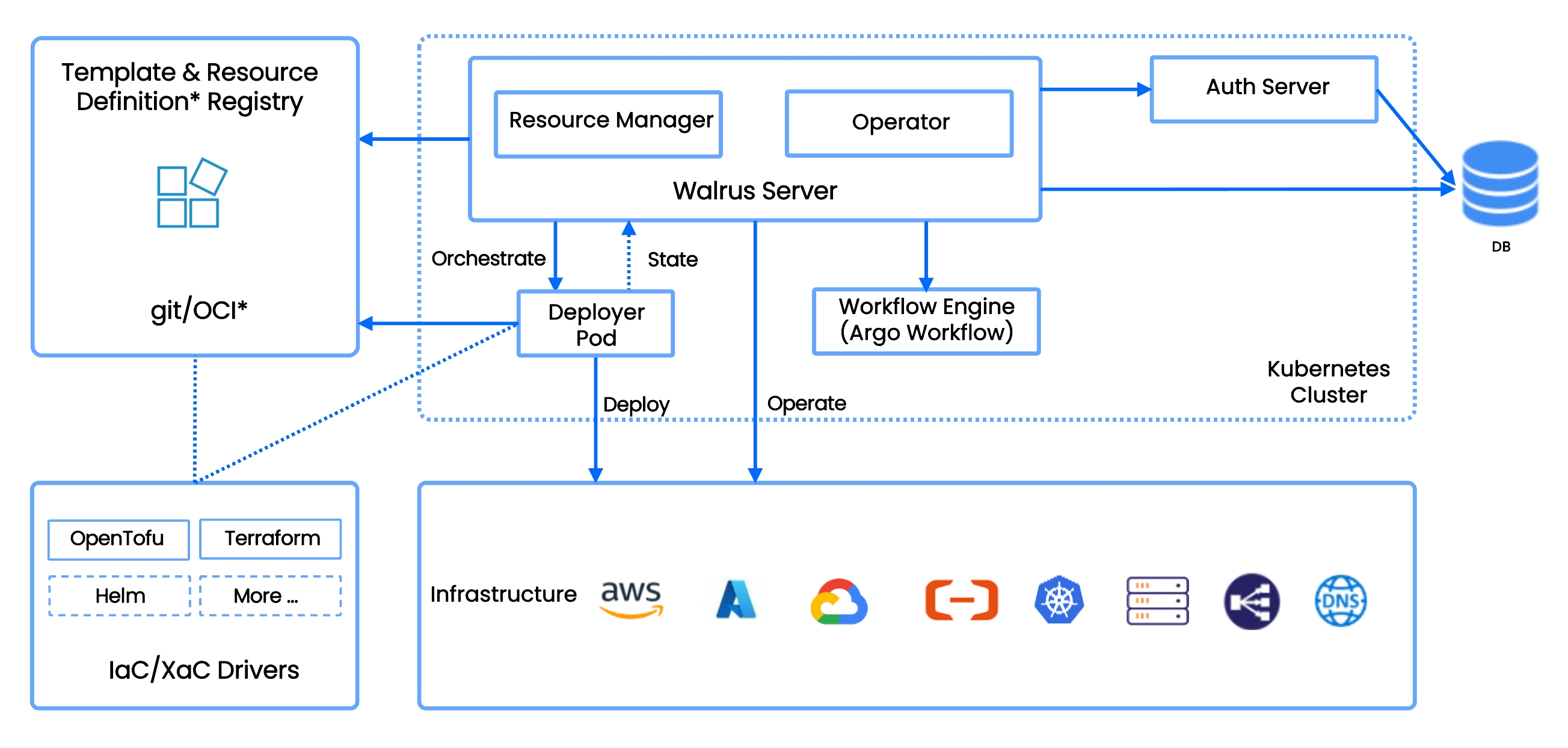Terraform, with its Enterprise and Cloud offerings, has been a reliable platform for organizations to deploy and manage infrastructure in the dynamic world of Infrastructure as Code (IaC).
However, as user needs and preferences shift, organizations are exploring alternatives to Terraform Cloud/Enterprise driven by cost concerns, flexibility requirements, and the imperative to streamline complexity.
While Terraform Cloud/Enterprise remains a prevalent choice, it possesses certain limitations that Walrus effectively addresses. This article outlines the main differences between the two tools based on the following factors:
Abstraction and Flexibility
Environments management
Ecosystems and extensibility
Licensing
What is Walrus?
Walrus is an open-source application platform based on IaC tools, including OpenTofu, Terraform and others, that ochestrates your entire application systems (including application services, resource dependencies) and enables developers with self-service capabilities.

Walrus simplifies Kubernetes and other infrastructure management by using a unified abstraction layer called Resource Definition. DevOps teams create this layer, which combines IaC templates, matching rules, pre-set parameters, and UI Schema. This enables developers to self-deploy infrastructures that meet cost, operational, and security requirements. With this feature, you can deploy an application to multiple infrastructures or environments simultaneously.
One of the main advantages of Walrus is its ability to simplify environment and resource management in a single pane of glass. Specifically, Walrus offers a clear dependency graph within the system and collects resource operations in a single view. This eliminates the need to switch between different windows, improving the overall experience and making it easier to handle complex resource management tasks.
What is Terraform Cloud/Enterprise?
Terraform Cloud is a platform developed by Hashicorp that helps with managing your Terraform code. It is used to enhance collaboration between developers and DevOps engineers, simplify your workflow, and improve overall security around the product.
Terraform Enterprise is a self-hosted distribution of Terraform Cloud. It offers enterprises a private instance of the Terraform Cloud application with no resource limits and additional enterprise-grade architectural features like audit logging and SAML single sign-on.
Walrus and Terraform Enterprise Differences
Abstraction and Flexibility
Walrus has two layers of abstraction: IaC templates (including Terraform modules) and Resource Definition, whereas Terraform Cloud/Enterprise offers a single abstraction layer, Terraform module.
With Walrus, operators can set up IaC templates that developers can leverage for self-service resource provisioning and deployments. Furthermore, Resource Definition empowers operators to establish and enforce corporate policies, dictating the usage, configuration, and deployment permissions of cloud resources. Consequently, developers are freed from the intricacies of deploying suitable infrastructure for their applications, enabling them to concentrate on coding.
This architecture allows Walrus to maintain Terraform code DRY (Don't Repeat Yourself), ensuring a unified abstraction across platforms and clouds without exposing technical intricacies to end-users. We will post a blog to give more details on how this architecture works. Stay tuned!
What's more, Walrus provides UI schema and HCL validation as input controls, which is an advantage over Terraform Cloud/Enterprise's HCL-only provision. Customizing the UI schema helps personalize the user interface and reduce configuration complexity.
Environments Management
Unlike Terraform Cloud/Enterprise's workspace, which is confined to a single Terraform module, Walrus provides a more flexible approach to infrastructure management. Walrus introduces the concept of Environment, which allows resources to exist as individual Terraform modules managed independently within an environment. This setup enables users to orchestrate multiple modules, sidestepping the complexity associated with managing large modules and facilitating infrastructure management akin to microservices.
Ecosystems and Extensibility
Walrus has a flexible architecture and an extensive ecosystem. It supports Terraform and OpenTofu, as well as seamlessly integrating various CD tools for GitOps implementation, such as ArgoCD and FluxCD. Furthermore, it officially supports Argo Workflow as a workflow engine, making it easy to integrate within diverse environments, including the Kubernetes ecosystem. Walrus can assist in expanding your IaC management to the Kubernetes ecosystem and utilizing its capabilities to achieve your goals.
Conversely, Terraform Cloud/Enterprise, being vendor-locked within the HashiCorp ecosystem, confines GitOps solutions to proprietary realms, limiting workflow flexibility.
Licensing
Walrus is 100% open source, following the Apache 2.0 license. In contrast, the community edition of Terraform changed its license to BSL last year, and the enterprise/cloud edition is proprietary.
Conclusion
Walrus offers more than just Terraform capabilities. It follows the methodology of platform engineering to simplify complexity for both developers and operations. In the future, Walrus will support Kubernetes architecture, heralding a paradigm shift whereby Kubernetes CRD will serve as a unified abstraction layer for deploying applications across infrastructures or environments at once. For cloud-native engineers, this enhancement holds the promise of significantly reducing cognitive loads.
It is 100% open source, welcome to give it a try!
If you are interested in Walrus, Welcome to our community:
Discord: https://discord.gg/fXZUKK2baF
Twitter/X: https://twitter.com/Seal_io
LinkedIn: https://www.linkedin.com/company/seal-io
Youtube: https://www.youtube.com/@Seal-io
